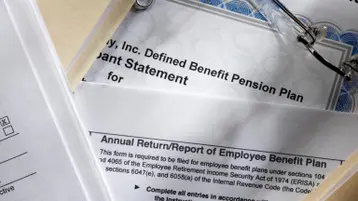What do You Mean I Can’t Change my Benefits? A Quick Guide to Open Enrollment and Changing Your Benefits Elections

Table of contents
- 1.Open enrollment
- 2.The IRS
- 3.Life status change events
- 4.My money, my choices
You decide to go shopping on the way home from work one night and a nice shirt catches your eye. On a whim, you buy the shirt but when you get home and try it on, you decide it’s not your style. This is nothing to stress over as you can usually return or exchange the shirt without hassle.
Many employees believe that group health benefits offered by their company should work this way as well, giving them the ability to “return” benefits they elected should they change their mind. Unfortunately, though, this is not the case. And while it seems counter-intuitive to pay for something you don’t want, strict rules and regulations govern employer benefit plan elections, making it a little more complicated than the purchase of a shirt.
To help you understand how the process works, I have outlined some important aspects of employee benefits that you can use to arm yourself when making – or changing – your benefits options.
Open enrollment
The most important concept when it comes to the timing of selecting benefits is “open enrollment.” Open enrollment is generally an annual event at most employers. During open enrollment, employees have a certain amount of time where they can add, change or waive benefits, including adding or removing dependents. Some employers have what is referred to as a passive enrollment, where employees can retain benefits they elect year over year without having to make an active election. Other employers require an active enrollment, which requires employees to re-elect their benefits, even if nothing will change for the coming year.
The IRS
The employees’ contributions for medical, dental, vision and flexible spending account benefits elected during open enrollment are deducted from their paycheck on a pre-tax basis. In other words, employees do not pay income tax on this money. The Internal Revenue Service (IRS) has issued regulations concerning benefits enrollment and making changes.
To retain their tax-favored status, employers are required to make sure they follow IRS regulations. Failure to do so can cause the plan to lose its tax-favored status, costing employees more money. So, when your HR services provider tells you that you cannot change coverage outside of open enrollment, they may seem like they are being restrictive or difficult but they are actually protecting the tax-favored status of the plan for all employees.
Life status change events
There is a legal way for employees to make changes outside of open enrollment. Certain events or “life status changes” trigger something called a “special enrollment period.” An employee qualifies for a special enrollment period when a life event may require they make a different benefits election or they add or lose a family member on their coverage. Some examples of life status change events include:
Birth or adoption of a child
Marriage or new domestic partnership
Divorce
Death of someone covered under the plan
Loss of other group coverage
Even special enrollment periods have rules. It is incumbent upon the employee to notify the employer within 30 days (60 for the birth of a child) of the event to qualify for special enrollment rights. If an employee fails to notify the employer in a timely fashion, the request to add, cancel or change benefits due to the life status change event can be denied. The employee would have to wait to make the desired change during the next open enrollment period, however long that might be.
My money, my choices
Employees will often get upset when their HR representative denies their request to make changes to their benefits outside of an open enrollment period. Often, we hear “but it’s my money!” While this is an understandable reaction, IRS regulations do not permit any benefits election changes outside of open enrollment unless there is a life status change event reported to the employer in a timely manner. This applies across the board to all employees.
Since there are very strict rules around benefits elections, it is even more crucial that employees take some time to research their choices and seek help if needed. An employer or HR services provider cannot tell you what plan to choose but you can refer to my previous post on choosing a medical plan.
Here are some quick tips as well:
Decide what type of plan will meet your needs. An HMO may be less expensive but will restrict your ability to see certain doctors. A PPO can be more expensive but may give broader service provider options.
Review any changes the carrier may have made to your current plan. Many times, employees end up in the wrong plan due to complacency and not actively reviewing their options during open enrollment. They don’t realize that a service they get regularly is no longer covered or a drug they take is no longer on the formulary. Take some time to review the changes so you do not have buyer’s remorse after it’s too late.
Consider your spouse’s coverage too. Compare the plans offered by both companies to make sure you are choosing what will work best for your family.
Having benefits is a great perk to any job but your family will typically have to live with the benefits you elect – good or bad – for a year at a minimum. Make sure that you carefully choose plans that provide the coverage you require and meet your financial needs.
This communication is for informational purposes only; it is not legal, tax or accounting advice; and is not an offer to sell, buy or procure insurance.
This post may contain hyperlinks to websites operated by parties other than TriNet. Such hyperlinks are provided for reference only. TriNet does not control such web sites and is not responsible for their content. Inclusion of such hyperlinks on TriNet.com does not necessarily imply any endorsement of the material on such websites or association with their operators.

Janice Scherwitz
Table of contents
- 1.Open enrollment
- 2.The IRS
- 3.Life status change events
- 4.My money, my choices






